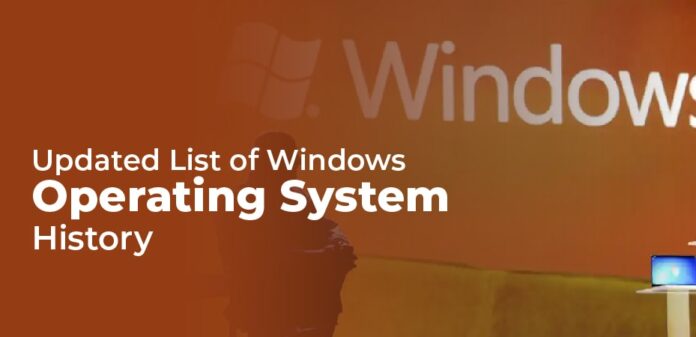Microsoft Corporation develops a family of operating systems called the Windows operating system (Windows OS). This article explores the history of Windows OS from 1985 to the present.
The Windows operating system (Windows OS) for desktop computers is actually a family of operating systems for personal computers called Microsoft Windows. Windows has traditionally dominated the world of personal computers, running on more than 75 percent of all computers. With the rise of Linux and Mac operating systems since the early 2000s, Windows dominance has lessened.
Windows provides graphical user interfaces (GUIs), virtual memory management, multitasking, and support for many peripheral devices. In addition to its Windows operating systems for personal computers, Microsoft offers operating systems for servers and mobile devices.

MICROSOFT WINDOWS OPERATING SYSTEMS FOR PCS:
The following is a history of the MS-DOS and Windows operating systems designed for PCs.
MS-DOS – Microsoft Disk Operating System (1981)
Microsoft developed MS-DOS for IBM-compatible personal computers. DOS’s initial versions were simple and resembled another operating system known as CP/M. Over the years, subsequent versions have become increasingly sophisticated as they have incorporated features of minicomputer operating systems.
Windows 1.0 – 2.0 (1985-1992)
Microsoft Windows 1.0 made its debut in 1985, and its name came from the computing boxes, or “windows,” that represented a fundamental aspect of the operating system. Windows 1.0 enabled users to access the windows by simply pointing and clicking instead of typing MS-DOS commands.
Microsoft released Windows 2.0 in 1987, which was designed to run on Intel 286 processors. It added desktop icons, keyboard shortcuts, and improved graphics capabilities.
Windows 3.0 – 3.1 (1990-1994)
Windows 3.0 offered better icons, performance, and advanced graphics with 16 colors designed for Intel 386 processors in May 1900. It was the first release to provide the standard “look and feel” of Microsoft Windows for years to come. There were many games in Windows 3.0, including Hearts, Minesweeper, and Solitaire. In 1992, Microsoft released Windows 3.1.
Windows 95 (August 1995)
The Windows 95 operating system was released in 1995 and was a major update. Over its predecessor, Windows 3.1, Windows 95 provided a number of important internal improvements. Aside from a new user interface, Windows 95 also featured a number of important improvements internally. Most importantly, it supported 32-bit applications, which meant that applications written specifically for this operating system ran much faster.
Windows NT 3.1 – 4.0 (1993 – 1996)
This version of Windows was released between 1993 and 1996. Windows NT (New Technology) was a 32-bit operating system, which supported preemptive multitasking. Windows NT is available in two versions: Windows NT Server, designed to act as a server in networks, and Windows NT Workstation, designed for use as a client.
Windows 98 (June 1998)
FAT32, AGP, MMX, USB, DVD, and ACPI were among the features supported by Windows 98. Active Desktop, though, integrated the Web browser (Internet Explorer) with the operating system. From the user’s perspective, there was no difference between accessing a document on a local hard drive or on a Web server halfway around the world.
Windows ME – Millennium Edition (September 2000)
The Windows Millennium Edition commonly referred to as “Windows Me,” was an update to the Windows 98 operating system. It included some features that would be part of the Windows 2000 operating system. In addition, this version removed the option to boot in DOS.
Windows 2000 (February 2000)
Windows 2000 abbreviated as “W2K” was an operating system for computer desktops and laptops that allowed users to run applications, connect to web and intranet sites, and access files, printers, and network resources. Four versions of Windows 2000 were released: Professional (for business desktops and laptops); Server (both a Web server and an office server); Advanced Server (for line-of-business applications); and Datacenter Server (for high-traffic networks).
Windows XP (October 2001)
Microsoft released Windows XP in 2001. The new operating system was built on the Windows 2000 kernel as well as a redesigned user interface, making it more stable and reliable than previous versions of Windows. Two versions of Windows XP were available: Professional and Home. In both editions of Windows 7, Microsoft emphasized mobility and built-in plug-and-play capabilities to connect to wireless networks. The operating system also supported the 802.11x wireless security standard. Microsoft’s Windows XP ended up becoming one of the best-selling products.
Windows Vista (November 2006)
Microsoft’s Vista operating system is an improvement over Windows XP in reliability, security, ease of deployment, performance and manageability. New features in this version include hardware problem detection, a faster startup time and low power consumption when Windows is in sleep mode. Windows Vista was noticeably more responsive than Windows XP on identical hardware in many cases. With Windows Vista, desktop configuration management was centralized and simplified, which reduced the cost of updating systems. For other versions info, read our blog on daily basis. I hope you will love it.




